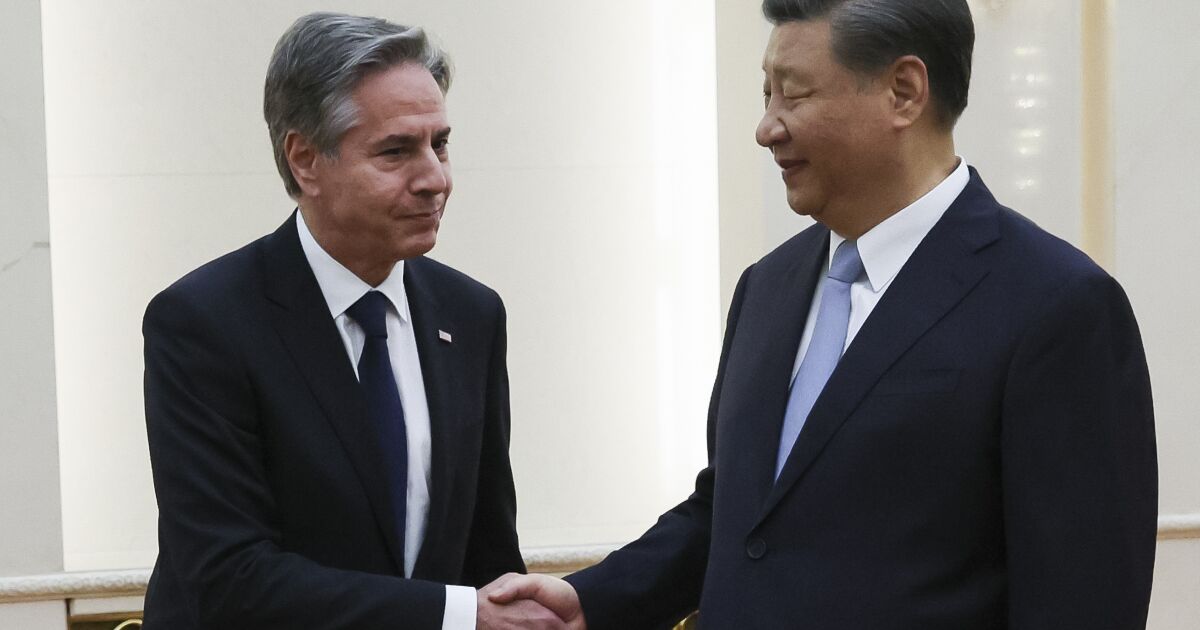When Secretary of State Antony J. Blinken went to Beijing last week to try to repair the frayed relationship between the United States and China, both sides kept expectations low.
For months, the two superpowers have clashed over a wide range of issues: the alleged Chinese spy balloon that wandered across the United States in February, U.S. attempts to block China from advanced semiconductor technology, and military near-collisions at sea and in the air.
Both countries agreed they needed to stop the rivalry from spiraling into open conflict and “build a floor” under the relationship — which is exactly what President Biden and Chinese President Xi Jinping said they had already done at a summit meeting eight months ago. That floor didn’t stay built — hence last week’s call for a repairman.
By that modest standard, Blinken succeeded. The floor has been patched, but it’s still pretty shaky.
“It’s good that they recognized that they need to talk when the relationship is veering into dangerous territory,” said Bates Gill, a China expert at the Asia Society in New York. “But talking is still going to be very difficult.”
The drive toward peaceful coexistence still looks accident-prone. Only a day after Blinken left Beijing, Biden touched off a brief furor when he told donors that Xi hadn’t known about the alleged spy balloon, which he called “a great embarrassment for [a] dictator.” A Chinese Foreign Ministry spokesperson called the remark “absurd and irresponsible.”
The underlying problem, deeper than any Biden gaffe, is that the two countries don’t merely have different goals; they view the world from different premises.
In Xi’s view, China is rising toward its rightful role as Asia’s dominant country and the world’s leading economic power, while the United States is a nation in decline.
U.S. officials understandably don’t buy that narrative. They correctly argue that China has bullied its smaller neighbors, stolen Western technology and engaged in unfair trade practices.
Even when they try to bridge those differences, the two governments often manage to talk past each other.
When Biden entered the White House in 2021, his aides tried to come up with a useful, perhaps inoffensive framework for their approach to China. As Blinken put it: “We’ll compete with confidence, cooperate when we can and confront when we must.”
The Chinese hated it.
“They see ‘competition’ as meaning there’s a winner and a loser,” Gill said. “They think our version of competition is about America winning and China losing.”
Beyond those differences, several major disagreements between the two countries are probably insoluble in the foreseeable future.
China believes it has an inalienable right to take over Taiwan; the United States has long been committed to helping the independent island defend itself.
Xi’s economic ambitions focus on making China a high-tech colossus; Biden believes U.S. security requires blocking Beijing from advanced semiconductor technology.
Now add the Biden administration’s success building alliances with other countries — including India, whose prime minister, Narendra Modi, was feted at the White House last week — and the European Union, even though it’s China’s biggest economic partner.
Xi’s regime hasn’t done as well at making friends. China’s only real allies are Russia and North Korea.
All of these factors make it hard to find space for U.S.-Chinese cooperation, even when it should be relatively easy.
For example, Blinken’s request for military contacts to prevent accidental conflicts fell on deaf ears because the Chinese fear it’s a trap.
“They don’t want to approach the issue from the standpoint of international law, because that might give us the right to fly or sail where they don’t want us,” said Bonnie Glaser of the German Marshall Fund. “If it became safe for us to conduct these flights, they’d see that as a win for us.”
The clearest outcome of Blinken’s trip will be a visit to Washington by China’s foreign minister, Qin Gang — and, with luck, a meeting between Biden and Xi in San Francisco this fall.
But their agenda will be a familiar one: reducing the chances of U.S.-China conflict by repairing the same shaky floorboards again and again.


